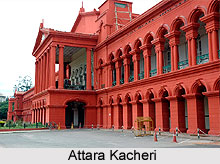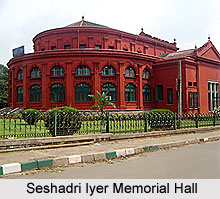Monuments in Cubbon Park have a rich cultural importance. The official gardens from the central hall of original government offices now the Karnataka High Court, extends along the real promenade developed symmetrically with avenues, to the Museum building. Another significant artistic structure in Iyer Hall that houses Central Library with rose gardens as a frontage. Other buildings that are situated within or at periphery of park are 1) the Indira Priyadarshini Children`s Library, 2) the Venkatappa Art Gallery, 3) the Aquarium (stated to be the second largest in India), 4) the YMCA, 5) Yuvanika - the State Youth Centre, 6) Century Club, 7) Press Club, 8) Jawahar Bal Bhavan, 9) Tennis Pavilion, 10) the Cheshire Dyer Memorial Hall and 11) the Ottawa Chatter.
A bandstand in an octagonal shape has made with cast iron was set up in the early part of 1900s. Before India gained independence, the British Royal Air Force used to play western band music at the band stand every Saturday evening. A special pull for children is the well planned amusement for children as part of Jawahar Bal Bhavan, which has the toy train, Puttani Express that runs (0.75 miles or 1.2 km) within the Park, the Doll museum and a boating facility. A 20 million year old fossilized tree - a gift from the Geological Survey of India, is also reported at the park. Monuments in the form of marble statues in name of Queen Victoria (set up in the year 1906), King Edwards VII (set up in 1919), Major General Sir Mark Cubbon, Chamarajendra Wodeyar (installed in 1927) and Sir K. Sheshadri Iyer (installed (in 1913) are seen located in front of the historical buildings within the park
Attara Kacheri at Cubbon Park
 Built during the British rule in the year 1864, Attara Kacheri is a stone construction in a strong red tinge, a two storied building with Corinthian columns in Gothic Style of architecture and is situated at the way in to the Park. Public offices, (Secretariat of the Government of Karnataka) were located here from the year 1868 to 1956 which, later were moved to Vidhana Soudha, opposite to it. Now the building houses the Karnataka High Court. In the Central Hall a portrait of Sir Mark Cubbon decorates the ceiling. An equestrian statue of Cubbon by Baron Marochetti is located at the back of the building.
Built during the British rule in the year 1864, Attara Kacheri is a stone construction in a strong red tinge, a two storied building with Corinthian columns in Gothic Style of architecture and is situated at the way in to the Park. Public offices, (Secretariat of the Government of Karnataka) were located here from the year 1868 to 1956 which, later were moved to Vidhana Soudha, opposite to it. Now the building houses the Karnataka High Court. In the Central Hall a portrait of Sir Mark Cubbon decorates the ceiling. An equestrian statue of Cubbon by Baron Marochetti is located at the back of the building.
Museum at Cubbon Park
The State Archaeological Museum, one of the oldest in India, built in 1876 by Colonel Sankey, located within the Park, is akin to the design of Attara Kacheri in its architectural style and hue. While the original collection in the museum belonged to Benjamin L. Rice of the Mysore Gazetteer, antiquities from Mohenjodaro period are on display in the Museum. Exhibits in the Museum include specimens of Vijaynagara and Halebid architecture, ancient coins and stone inscriptions as old as 5000 years
Seshadri Iyer Memorial Hall
 Built in the year 1915, in a conventional European style with Carinthian and Tuscan columns, Seshadri Iyer Memorial Hall, in honour of Sir K. Seshadri Iyer who was Dewan of Mysore State from 1883 to 1901, is an impressive red building with gables. It houses the Seshadri Memorial Library. The memorial building is ensconced in the middle of the park, framed by the plants of the park and with a gorgeous frontage of the rose garden. The Library has an area of 300 km square and functions as the Apex of the Karnataka Public Libraries system, which is governed by State Library Authority. In the year 2000, the Library, for the best state central library in India, was awarded the Raja Ram Mohan Roy Library Foundation Award in recognition of its outstanding contribution to meritorious services rendered in the spread of knowledge and gearing up of library movement in the city of Bangalore in particular and in the state of Karnataka in general.
Built in the year 1915, in a conventional European style with Carinthian and Tuscan columns, Seshadri Iyer Memorial Hall, in honour of Sir K. Seshadri Iyer who was Dewan of Mysore State from 1883 to 1901, is an impressive red building with gables. It houses the Seshadri Memorial Library. The memorial building is ensconced in the middle of the park, framed by the plants of the park and with a gorgeous frontage of the rose garden. The Library has an area of 300 km square and functions as the Apex of the Karnataka Public Libraries system, which is governed by State Library Authority. In the year 2000, the Library, for the best state central library in India, was awarded the Raja Ram Mohan Roy Library Foundation Award in recognition of its outstanding contribution to meritorious services rendered in the spread of knowledge and gearing up of library movement in the city of Bangalore in particular and in the state of Karnataka in general.



















